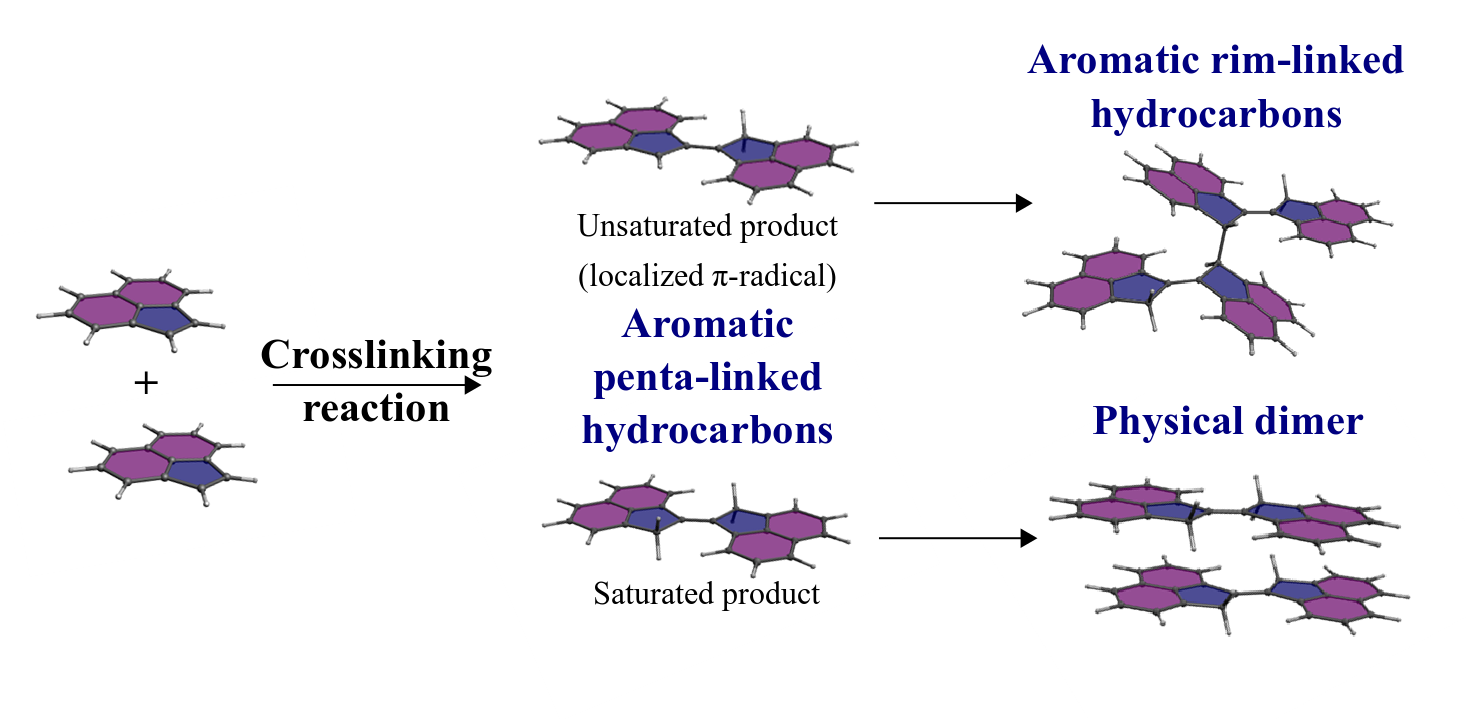Aromatic penta-linked hydrocarbons in soot nanoparticle formation
- A new crosslinking reaction between two pentagonal rings around the periphery of aromatic molecules is proposed to produce a planar aromatic penta-linked hydrocarbon (APLH) complex.
- The physical and chemical dimerizations of the APLH are investigated using different modeling techniques.
- The APLH clusters as effectively as a pericondensed species of the same size.
- The APLH radicals can chemically dimerize forming a π-stacked and covalently bonded aromatic rim-linked hydrocarbon complex of considerable stability.
 A new crosslinking reaction between two pentagonal rings around the periphery of planar pericondensed aromatic molecules is proposed and its impact on soot nanoparticle formation explored. The reaction mechanism was computed, using density functional theory, between an aryl-type σ-radical on a rim-based pentagonal ring attacking another rim-based pentagonal ring. A hydrogen migration allowed for the formation of a double bond forming a planar aromatic penta-linked hydrocarbon (APLH) complex, recently experimentally observed. The clustering of this planar species is compared with a pericondensed polyaromatic hydrocarbon (PCAH) and an aromatic aryl-linked hydrocarbon (AALH) using molecular dynamics and metadynamics. Similar clustering is found for the investigated species compared with a pericondensed structure of similar mass indicating enhanced physical interactions after forming the crosslink. Finally, a further crosslink is possible between the unsaturated pentagonal ring sites forming an aromatic rim-linked hydrocarbon (ARLH) complex of considerable stability. This was confirmed by simulating the stable molecular dynamics of such a complex with on-the-fly quantum forces from a quantum semi-empirical method, revealing possible reactions under flame conditions that might play a role in soot nucleation.
A new crosslinking reaction between two pentagonal rings around the periphery of planar pericondensed aromatic molecules is proposed and its impact on soot nanoparticle formation explored. The reaction mechanism was computed, using density functional theory, between an aryl-type σ-radical on a rim-based pentagonal ring attacking another rim-based pentagonal ring. A hydrogen migration allowed for the formation of a double bond forming a planar aromatic penta-linked hydrocarbon (APLH) complex, recently experimentally observed. The clustering of this planar species is compared with a pericondensed polyaromatic hydrocarbon (PCAH) and an aromatic aryl-linked hydrocarbon (AALH) using molecular dynamics and metadynamics. Similar clustering is found for the investigated species compared with a pericondensed structure of similar mass indicating enhanced physical interactions after forming the crosslink. Finally, a further crosslink is possible between the unsaturated pentagonal ring sites forming an aromatic rim-linked hydrocarbon (ARLH) complex of considerable stability. This was confirmed by simulating the stable molecular dynamics of such a complex with on-the-fly quantum forces from a quantum semi-empirical method, revealing possible reactions under flame conditions that might play a role in soot nucleation.
- This paper draws from preprint 254: Aromatic penta-linked hydrocarbons in soot nanoparticle formation
- Access the article at the publisher: DOI: 10.1016/j.proci.2020.09.029



